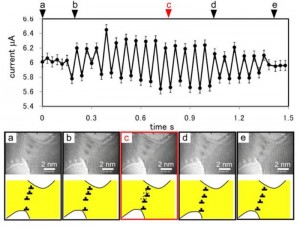An Atomic Scream Dislocation Movement Causes Electrical Oscillations in Nanocontacts


Electrical current oscillation of gold nanocontact due to dislocation movement. © Tadashi Ishida
The current of the gold nanocontact oscillated for 1.16 s before and after the dislocation movement. (a?e) TEM images and schematic illustrations of the dislocation movement inside the gold nanocontact.
Recent electronic devices have drastically changed and enriched our quality of life by the miniaturization of wiring and transistors thanks to nanotechnology. These nano wirings and transistors are so small that they may be easily affected by noises caused by atomic level structural fluctuations, e.g. the motion of dislocations, disordered crystalline domains that can be deformed by heat and mechanical stress. However, it is difficult to detect such noise because dislocation movements take place within regions at the nanoscale. Tadashi Ishida and colleagues of Institute of Industrial Science in the University of Tokyodetected a noise like an “atomic scream,” caused by the motion of dislocations. The researchers measured the electric current through a nanocontact between opposing gold tips in a transmission electron microscope (TEM) with a cross-section of only tens of atoms. When a dislocation moved, current signal noise with an amplitude around 10 % of signal level was detected over a base current of 6 ?A at 1 mV (see figure). It is suggested that the noise driven by the dislocation motion may reach as large as 10 % of the signal when the device size becomes less than 10 nm. Resolving this newly-observed form of noise will be a key issue for the development of future high-performance nanoscale devices.
Press release (Japanese)
Paper
Tadashi Ishida, Kuniyuki Kakushima, Teruyasu Mizoguchi and Hiroyuki Fujita,
“Role of Dislocation Movements in Electrical Conductance of Nanocontacts”,
Scientific Reports 2 623 Online Edition: 2012/9/4 (Japan time), doi: 10.1038/srep00623.
Article link
Links
Institute of Industrial Science
Specially Promoted Research(Japanese)






